
IMPORTANT: All Liberty Pumps products are supplied with their own
separate Installation/Operation/Maintenance manuals. Ensure receipt of
these manuals, and that they are read and understood prior to installation.
For questions, call Liberty Pumps customer service at 800-543-2550.
Installer: Manual must remain with owner or
system operator/maintainer.
Prior to installation, record information
from pump nameplate for future reference:
System:
Model(s):
Keep this manual handy for future reference.
For replacement manual, visit LibertyPumps.com,
or contact Liberty Pumps at 800-543-2550.
Retain dated sales receipt for warranty.
Serial(s):
7000 Apple Tree Avenue
Bergen, NY 14416
ph: 800-543-2550
fax: 585-494-1839
www.LibertyPumps.com
Control Panel:
Mfg Date:
Install Date:
Installation Manual
7353000H
Copyright © Liberty Pumps, Inc. 2020
All rights reserved.
Duplex Grinder Systems
D3648/D3660/D3672/D3684/
D3696/D36120-Series
• 36” Diameter Fiberglass Basin
• Available in 48”, 60”, 72”, 84”, 96” and 120” Heights
Features
• LSG Grinder Pump (2 hp, 208/230V)
-or-
•LSGX Grinder Pump (2 hp, 208–230V)
• Pre-mounted Float System
– QuickTree® Float System on heights to 84”
• GR20 Guide Rail System
• NEMA 4X Duplex Control Panel
• NEMA 4X Junction Box
D3672-Series Shown

2 | EN Copyright © Liberty Pumps, Inc. 2020
All rights reserved. 7353000H
Contents
Safety Precautions. . . . . . . . . . . . . . . . . . . . . . . . . . . . . 2 | EN
Introduction . . . . . . . . . . . . . . . . . . . . . . . . . . . . . . . . . . 3 | EN
Model Specifications. . . . . . . . . . . . . . . . . . . . . . . . . . . 4 | EN
Basin Installation . . . . . . . . . . . . . . . . . . . . . . . . . . . . . 4 | EN
Installation. . . . . . . . . . . . . . . . . . . . . . . . . . . . . . . . . . . 6 | EN
Operation, Maintenance, Troubleshooting. . . . . . . . . 7 | EN
Warranty . . . . . . . . . . . . . . . . . . . . . . . . . . . . . . . . . . . . 8 | EN
Safety Guidelines
Safety Precautions
Accidental contact with electrically live parts, items, fluid, or
water can cause serious injury or death.
Always disconnect pump(s) from power source(s) before
handling or making any adjustments to either the pump(s),
the pump system, or the control panel.
All installation and maintenance of pumps, controls,
protection devices, and general wiring shall be done by
qualified personnel.
All electrical and safety practices shall be in accordance with
the National Electrical Code
®
, the Occupational Safety and
Health Administration, or applicable local codes and
ordinances.
Do not remove cord and strain relief, and do not connect
conduit to pump.
Pump shall be properly grounded using its supplied
grounding conductor. Do not bypass grounding wires or
remove ground prong from attachment plugs. Failure to
properly ground the pump system can cause all metal
portions of the pump and its surroundings to become
energized.
Do not handle or unplug the pump with wet hands, when
standing on damp surface, or in water unless wearing
Personal Protective Equipment.
Always wear dielectric rubber boots and other applicable
Personal Protective Equipment (PPE) when water is on the
floor and an energized pump system must be serviced, as
submerged electrical connections can energize the water. Do
not enter the water if the water level is higher than the PPE
protection or if the PPE is not watertight.
Do not lift or carry a pump or a float assembly by its power
cord. This will damage the power cord, and could expose the
electrically live wires inside the power cord.
The electrical power supply shall be located within the length
limitations of the pump power cord, and for below grade
installations it shall be at least 4 ft (1.22 m) above floor level.
Do not use this product in applications where human contact
with the pumped fluid is common (such as swimming pools,
fountains, marine areas, etc.).
Protect the power and control cords from the environment.
Unprotected power and control (switch) cords can allow
water to wick through ends into pump or switch housings,
causing surroundings to become energized.
Single-phase 208/230V pumps shall only be operated
without the float switch by using the circuit breaker or panel
disconnect.
Some products may have internal capacitors that could cause
shock. Avoid contact with plug ends after removing from
energy source.
Do not use an extension cord to power the product.
Extension cords can overload both the product and extension
cord supply wires. Overloaded wires will get very hot and can
catch on fire.
This product requires a separate, properly fused and
grounded branch circuit, sized for the voltage and amperage
requirements of the pump, as noted on the nameplate.
Overloaded branch circuit wires will get very hot and can
catch on fire. When used, electrical outlets shall be simplex of
the appropriate rating.
Do not use this product with or near flammable or explosive
fluids such as gasoline, fuel oil, kerosene, etc. If rotating
elements inside pump strike any foreign object, sparks may
occur. Sparks could ignite flammable liquids.
This safety alert symbol is used in the manual
and on the pump to alert of potential risk for
serious injury or death.
This safety alert symbol identifies risk of
electric shock. It is accompanied with an
instruction intended to minimize potential
risk of electric shock.
This safety alert symbol identifies risk of fire.
It is accompanied with an instruction
intended to minimize potential risk of fire.
This safety alert symbol identifies risk of
serious injury or death. It is accompanied
with an instruction intended to minimize
potential risk of injury or death.
Warns of hazards which, if not avoided, will
result in serious injury or death.
Warns of hazards which, if not avoided, could
result in serious injury or death.
Warns of hazards which, if not avoided, could
result in minor or moderate injury.
Signals an important instruction related to
the pump. Failure to follow these instructions
could result in pump failure or property
damage.
Read every supplied manual before using
pump system. Follow all the safety instructions
in manual(s) and on the pump. Failure to do
so could result in serious injury or death.
RISK OF ELECTRIC SHOCK
RISK OF FIRE

7353000H Copyright © Liberty Pumps, Inc. 2020
All rights reserved. 3 | EN
Sewage and effluent systems produce and may contain
flammable and explosive gases. Prevent introduction of
foreign objects into basin as sparks could ignite these gases.
Exercise caution using tools and do not use electronic devices
or have live, exposed electrical circuits in or around basins,
open covers and vents.
These pumps are not to be installed in locations classified as
hazardous in accordance with the National Electric Code
®
,
ANSI/NFPA 70.
Energizing the control panel or breaker for the first time is
potentially dangerous. Licensed electrical personnel should
be present when the panel or breaker is energized for the first
time. If faults caused by damage or poor installation practices
have not been detected, serious damage, injury or death can
result when power is applied.
Do not modify the pump/pump system in any way.
Modifications may affect seals, change the electrical loading
of the pump, or damage the pump and its components.
All pump/pump system installations shall be in compliance
with all applicable Federal, State, and Local codes and
ordinances.
Do not allow children to play with the pump system.
Do not allow any person who is unqualified to have contact
with this pump system. Any person who is unaware of the
dangers of this pump system, or has not read this manual,
can easily be injured by the pump system.
In 208/230V installations, one side of the line going to the
pump is always “hot”, whether the float switch is on or off. To
avoid hazards, install a double pole disconnect near the
pump installation.
Vent basin in accordance with local code. Proper venting of
sewer and effluent gases alleviates poisonous gas buildup
and reduces the risk of explosion and fire from these
flammable gases.
Wear adequate Personal Protective Equipment when working
on pumps or piping that have been exposed to wastewater.
Sump and sewage pumps often handle materials that can
transmit illness or disease upon contact with skin and other
tissues.
Do not enter a pump basin after it has been used. Sewage
and effluent can emit several gases that are poisonous.
Do not remove any tags or labels from the pump or its cord.
Keep clear of suction and discharge openings. To prevent
injury, never insert fingers into pump while it is connected to
a power source.
Do not use this product with flammable, explosive, or
corrosive fluids. Do not use in a flammable and/or explosive
atmosphere as serious injury or death could result.
This product contains chemicals known to the State of
California to cause cancer and birth defects or other
reproductive harm. www.p65warnings.ca.gov.
A grinder pump contains metal parts that rotate at high
speeds. Be careful around pump base while power is
connected. Make sure that the pump is either in the tank or
clear from people and wires when in operation.
Verify a Redundant Check Valve Assembly (curb stop and
check valve) is installed between the pump discharge and
the street main, as close to the public right-of-way as
possible, on all installations to protect from system
pressures.
Do not dispose of materials such as paint thinner or other
chemicals down drains. Doing so could chemically attack and
damage pump system components and cause product
malfunction or failure.
Do not use these pumps with fluid over 140°F (60°C).
Operating the pump in fluid above this temperature can
overheat the pump, resulting in pump failure.
Do not use pump system with mud, sand, cement,
hydrocarbons, grease, or chemicals. Pump and system
components can be damaged from these items causing
product malfunction or failure. Additionally, flooding can
occur if these items jam the impeller or piping.
Do not run dry.
The Uniform Plumbing Code
®
states that sewage systems
shall have an audio and visual alarm that signals a
malfunction of the system, to reduce the potential for
property damage.
Do not exert heavy pressure or run heavy equipment on the
backfill material as this could cause the tank to collapse.
Introduction
Pumps, alarm, and control panel are supplied with their own
separate manuals. Ensure receipt of these manuals, and that they
are read and understood prior to installing and using this system.
Familiarity with the pumps, alarm, and control panel is critical.
This manual provides a brief overview of the system, and deals
mainly with inspection and installation of the basin. It does not
cover the specifics of the pump, alarm, and control panel
operation. For questions, call Liberty Pumps customer service at
800-543-2550.
Identification
Information about the system can be found on a tag located on
the basin cover. This identifies the system model number as well
as the horsepower, voltage, and amp draw for the pump. Pump
tag is located on the pump. Duplicate pump tags are packaged
with the system. These should be mounted on the basin cover or
at the control panel for accessibility and immediate pump
information.
Inspection
Inspect the system upon arrival to ensure that there is no shipping
damage. Pay careful attention to the condition of the fiberglass
basin, control floats, pump guide rail brackets, and control panel.
Notify the carrier immediately if there is any damage.
Read all instructions and become familiar with the system’s
operation prior to proceeding with the installation.
RISK OF SERIOUS INJURY OR DEATH

4 | EN Copyright © Liberty Pumps, Inc. 2020
All rights reserved. 7353000H
Model Specifications
For a complete listing of models and their specifications, refer to
http://www.LibertyPumps.com/About/Engineering-Specs. The
pump nameplate provides a record of specific pump information.
Basin Installation
This is a brief reference to the recommended methods and
procedures for installing Liberty Pumps basins to ensure that
damage or premature failure of the basin does not occur.
This section is not intended to serve as a basic instructional guide.
The installation of Liberty Pumps sump and sewage basins is a
specialized skill and is assumed that the individuals who install our
products and refer to this section will have basic understanding of
such procedures as excavating, backfilling, pipefitting, and
electrical work. No amount of written instruction by a
manufacturer or regulatory agency will convert an inexperienced,
under-supervised laborer into a skilled, experienced mechanic.
The ability to recognize and correctly respond to abnormal
conditions during a basin installation requires field experience as
well as mechanical aptitude. Figure 1 is provided for reference.
In addition to proper system engineering and competent
manufacturing, the use of basin installers who have both practical
experience and integrity to assist that the basin be installed
properly, constitutes the greatest protection from catastrophic
basin failure and liability exposure.
Basin Handling
General Handling
Although the exterior surfaces of the fiberglass basins are
designed to withstand normal handling, they can be damaged
during transportation and installation. Basins must not be
dropped, dragged, or handled with sharp objects, and with the
exception of the minimal movement involved in a visual
inspection, must not be rolled.
Unloading, Lifting, and Lowering
Under no circumstances are the use of chains or cables
around the basin shell permitted.
The proper way to move a basin is by lifting it, using chains or
cables with the optional lifting lugs (not more than a 30° angle), or
by using a non-marring sling around the basin. Before any
attempt is made to move a basin, verify that all equipment and
accessories have sufficient capacity and reach to lift and lower the
basin without dragging and/or dropping. Maneuver the basin with
guide ropes attached to the sides.
Pre-Installation Inspection
Confirm adherence to the project’s specifications before
installation. Physically and visually inspected basin, pumps, valves,
equipment, and piping materials before installation. Notify the
carrier immediately if there is any damage. If the basin or any of its
internal components are damaged, suspend installation until a
determination of the extent of damage can be made by Liberty
Pumps or its agent. Any repairs must be first authorized in writing
by Liberty Pumps and then be done in accordance with Liberty
Pumps instructions.
Storage
Store the basin in a secure, controlled area where the potential for
accidental damage or vandalism will be minimized. The storage
area must be free from sharp objects, rocks, and any other foreign
solutions or materials that could cause damage to the basin.
Chock the basin until it is needed for installation and, if windy
conditions are possible, secure the basin with non-marring
restraints of a size and number adequate for securing the basin.
Excavation
Locate all overhead and underground utilities before
excavating.
Excavation Considerations
The excavation must provide adequate space for the basin, piping,
and other buried equipment, and for the replacement and
compaction of backfill materials particularly around the basin
walls. The size, shape, and wall slope of the excavation should be
determined by soil conditions, depth of excavation, shoring
requirements, and if workers are required to enter the excavation,
safety considerations and federal, state, county, and municipal
regulations.
Excavation Location
Excavation for an underground basin must be made with due care
to avoid undermining foundations of existing structures and
contact with underground utilities. In the absence of building
codes or regulations, maintain a minimum distance of 5 feet plus
a slope of 45° from the bottom of the compacted sub-base to the
bottom of the adjacent structures, foundations, footings, and
property lines. Additional distances may be required to ensure
that any loading carried or created by the foundations and
supports cannot be transferred to the basin.
Maximum Basin Burial Depth
If burial depth is greater than the basin height, contact Liberty
Pumps to determine if additional wall reinforcement is required
and secure written authorization.
Excavated Materials Handling
Carefully store excavated materials that cannot be removed from
the job site as far from the edge of the basin excavation as
possible. Unless approved for use as backfill, securely store
excavation materials separate from the approved backfill
materials.
RISK OF SERIOUS INJURY OR DEATH
RISK OF SERIOUS INJURY OR DEATH

7353000H Copyright © Liberty Pumps, Inc. 2020
All rights reserved. 5 | EN
Work Area Safety
Safe installation procedures are the sole responsibility of the basin
installer. Work safety requirements are defined in US Department
of Labor 29 CFR 1926, Subpart P: Excavations.
Backfill
Careful selection, placement, and compaction of approved backfill
material is critical to a successful basin installation. Among the
common problems associated with basin leaks and premature
failures are:
• Use of incorrect backfill material
• Inadequate or improper placement or compaction
• Rocks, clods, or debris left in the excavation or basin
• Voids under or around the perimeter of the basin
• Failure to prevent the migration of backfill materials
Basin Placement
Placement of a basin on a concrete pad or compacted
sub-base smaller than the total basin bottom area or on
intermediate supports (saddles) will cause uneven
distribution of loads. This may contribute to structural failure
and is never permitted.
Cover the bottom of the basin excavation with suitably graded,
leveled, and compacted backfill material to a depth of at least 12”
(compacted sub-base). If a concrete hold-down/anti-flotation pad
is required, this bedding can be reduced to a depth of at least 6”.
Carefully lower the basin into the excavated area and center on
the compacted backfill or concrete pad.
Backfill Material
Ensure backfill material is clean, well granulated, free-flowing,
non-corrosive, and inert; free of ice, snow, debris, rock, or organic
material, all of which could damage the basin and interfere with
the compaction of the backfill material. The largest particles shall
not be larger than 3/4”. Not more than 3% (by weight) should
pass through a #8 sieve, and the backfill material must conform to
ASTM C-33, Paragraph 9.1 requirements. Approved backfill
materials include:
• Pea gravel, naturally rounded particles, with a minimum
diameter of 1/8” and a maximum diameter of 3/4”
• Crushed rock, washed and free-flowing angular particles
between 1/8” and 1/2” in size
Backfill Placement and Compaction
Do not exert heavy pressure or run heavy equipment on the
backfill material as this could cause the tank to collapse.
Compaction of backfill materials must be adequate to ensure the
support of the basin and to prevent movement or settlement.
Place backfill materials in 12” lifts and compacted to a minimum
soil modulus of 700 pounds per square foot.
Support Piping, Equipment and Accessories
Using the basin to support any loading carried or created by
piping, equipment, cribbing, bracing, or blocking is never
permitted.
Provide support for piping, equipment, and other accessories
during backfilling. During backfilling, temporary support must be
carefully installed and removed to prevent damage to the basin,
piping, and/or equipment.
Anchorage
When basin installations are located in areas subject to high water
tables or flooding, make provisions to prevent the basin, either
empty or filled, from floating. The buoyancy force to be offset is
determined primarily by the volume of the basin. The principle
offsetting factors include:
• Backfill materials
• Concrete hold-down pad
• Friction between the basin, backfill materials, and
surrounding soil
Anchorage Methods
All methods of anchoring the basin use the weight of the backfill
materials to offset the buoyancy forces. The use of supplemental
mechanical anchoring methods (i.e., a concrete hold-down pad)
increases the amount of backfill ballast that is mechanically
attached to the basin. The recommended method of attachment is
to pour concrete grout over the basin’s anti-flotation flange and
concrete hold-down pad.
Anchorage Requirements
Use “submerged” material weights when calculating
anchorage requirements.
Requirements of anchorage, thickness of concrete hold-down
pads, as well as the size of anchors and reinforcement must be
calculated for each installation based on the environmental
conditions of the specific installation.
Example: weight of concrete (150 pounds per cubic foot) minus
the weight of the water (62.4 pounds per cubic foot) equals a
“submerged” weight of 87.6 pounds per cubic foot.
RISK OF SERIOUS INJURY OR DEATH
RISK OF SERIOUS INJURY OR DEATH
RISK OF SERIOUS INJURY OR DEATH

6 | EN Copyright © Liberty Pumps, Inc. 2020
All rights reserved. 7353000H
Figure 1. Basin Installation Reference
Installation
All installation and maintenance of pumps, controls,
protection devices, and general wiring shall be done by
qualified personnel.
All electrical and safety practices shall be in accordance with
the National Electrical Code
®
, the Occupational Safety and
Health Administration, or applicable local codes and
ordinances.
Electrical Connections
With main power disconnected, complete pump and control panel
connections per wiring diagrams included with the pump and
control panel, as applicable. Verify connections. When complete,
check all wires for unintentional ground.
Alarm and Control Panel
Connect the alarm panel and control panel per their own
Installation manuals.
Connect pump and float switch leads to the control panel in
accordance with the instructions included with the unit.
1”
3/4”
1/2”
1/4”
30º maximum
Lifting cable or chain
Spreader bar
FINISH GRADE
Optional lifting lugs
Slope and size of excavation as per
OSHA and engineer’s specification.
In the absence of these,
consider condition of soil, depth of
excavation, and safety considerations
Basin anti-flotation flange
Compacted sub-base and/or concrete
slab as per engineer’s specification
FINISH GRADE
12” minimum backfill compacted to a minimum
soil modulus of 700 lbs per sq ft
Fiberglass basin as required
per engineer’s specification
Backfill material
Concrete grout as required
per engineer’s specification
CAUTION:
HANDLE WITH CARE
Do NOT drop
Do NOT impact
Do NOT roll
Do NOT wrap cable or
chain around basin
Compacted sub-base minimum 12” or 6”
when used with concrete hold-down pad
Adjacent structure, foundation,
footing, or property line
In the absence of building codes or
regulations, maintain a minimum distance
of 5 feet plus a slope of 45° from the
bottom of the compacted sub-base to the
bottom of the adjacent structure’s
foundation, footing, or property line.
NOTE: The intent of these installation instructions and illustration is to ensure that damage or
premature failure to the basin does not occur. These installation instructions and illustration are not
intended to preclude normal safety procedures that should be followed to prevent injury to personnel.
SAFE INSTALLATION PROCEDURES ARE ENTIRELY THE RESPONSIBILITY OF THE INSTALLER
Pea Gravel
Crushed Roc
k
BACKFILL MATERIAL REQUIREMENTS
5’-0”
minimum
45°
minimum
RISK OF ELECTRIC SHOCK

7353000H Copyright © Liberty Pumps, Inc. 2020
All rights reserved. 7 | EN
Discharge Line
Connect Schedule 80 PVC pipe to pump discharge. Do not
increase discharge piping to larger than 2”. Do not reduce
discharge to below the pump outlet size. The remainder of the
discharge line should be as short as possible with a minimum
number of turns to minimize friction head loss.
Inlet Line
Connect the inlet line to the inlet hub per engineer’s specifications.
Vent
The basin must be
completely sealed and
properly vented per local
health and plumbing code
requirements. The system is
designed to be vented
through the inlet to an
existing building vent stack.
In order to accomplish this,
there must be no traps
between the system inlet
and the nearest building
vent stack connection. If
this is not possible or
desirable per the
application, a vent flange or
grommet can be installed in
a hole cut into the cover.
Float Switches
Float switches are pre-mounted on a QuickTree for basins up to
84” height and mounted on a float bracket for 96” and 120” height
basins. For QuickTree removal, loosen the cord nut, locking clamp,
and pull the tree straight out of the tank.
The pump cycle is preset at the factory. The pump cycle can be
adjusted by loosening the cord grip and moving the “on” float up
or down. Adjustments of more than 3" in either direction are not
recommended—call customer service if the pump cycle needs to
be adjusted beyond this recommended level. The preset pump
levels are provided in Table 1.
Figure 2. Float Switches Side View
GR-Series Guide Rail System
The GR20 quick-disconnect assembly guide rail system provided
with the system is designed to allow easy installation and removal
of the pump. When installed correctly, it will seal and provide a
means to lift the pump without disconnecting any of the
discharge piping. Ensure installation is done as shown.
Operation, Maintenance, Troubleshooting
Refer to supplied pump, alarm, and control panel manuals. For
further questions, contact customer service at 800-543-2550 or
support@LibertyPumps.com.
Table 1. Factory Set Float Switch Levels
System OFF ON ALARM
D3648 13” 25” 31”
D3660 13” 28” 34”
D3672 13” 31” 37”
D3684 13” 34” 40”
D3696 13” 37” 43”
D36120 13” 43” 49”
SYSTEM
VENT
DISCHARGE
Ground Level
SEWAGE LINE
Guide Rail Base Grommet Location
Operating Position Disconnected Position
ALARM
OFF
ON
DISCHARGE
Grommet comes
greased and
installed
Rubber
sealing
grommet

8 | EN Copyright © Liberty Pumps, Inc. 2020
All rights reserved. 7353000H
Warranty
Liberty Pumps Wholesale Products Limited Warranty
Liberty Pumps, Inc. warrants that Liberty Pumps wholesale products are free from all factory defects in material and workmanship for a
period of three (3) years from the date of purchase (excluding batteries). The date of purchase shall be determined by a dated sales
receipt noting the model and serial number of the pump. The dated sales receipt must accompany the returned pump if the date of
return is more than three years from the date of manufacture noted on the pump nameplate.
The manufacturer's sole obligation under this Warranty shall be limited to the repair or replacement of any parts found by the
manufacturer to be defective, provided the part or assembly is returned freight prepaid to the manufacturer or its authorized service
center, and provided that none of the following warranty-voiding characteristics are evident:
The manufacturer shall not be liable under this Warranty if the product has not been properly installed, operated, or maintained per
manufacturer instructions; if it has been disassembled, modified, abused, or tampered with; if the electrical cord has been cut, damaged,
or spliced; if the pump discharge has been reduced in size; if the pump has been used in water temperatures above the advertised rating;
if the pump has been used in water containing sand, lime, cement, gravel, or other abrasives; if the product has been used to pump
chemicals, grease, or hydrocarbons; if a non-submersible motor has been subjected to moisture; or if the label bearing the model and
serial number has been removed.
Liberty Pumps, Inc. shall not be liable for any loss, damage, or expenses resulting from installation or use of its products, or for indirect,
incidental, and consequential damages, including costs of removal, reinstallation or transportation.
There is no other express warranty. All implied warranties, including those of merchantability and fitness for a particular purpose, are
limited to three years from the date of purchase. This Warranty contains the exclusive remedy of the purchaser, and, where
permitted, liability for consequential or incidental damages under any and all warranties are excluded.
7000 Apple Tree Avenue
Bergen, NY 14416
ph: 800-543-2550
fax: 585-494-1839
www.LibertyPumps.com
-
 1
1
-
 2
2
-
 3
3
-
 4
4
-
 5
5
-
 6
6
-
 7
7
-
 8
8
Liberty Pumps D3660LSG202-24 Installation guide
- Type
- Installation guide
- This manual is also suitable for
Ask a question and I''ll find the answer in the document
Finding information in a document is now easier with AI
Related papers
-
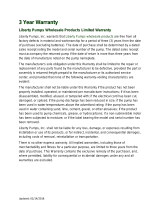 Liberty Pumps HCV150 User manual
Liberty Pumps HCV150 User manual
-
Liberty Pumps 253 User guide
-
Liberty Pumps 7386000N Installation guide
-
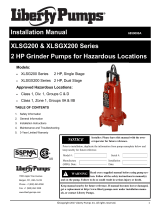 Liberty Pumps XLSG204M-5 Installation guide
Liberty Pumps XLSG204M-5 Installation guide
-
Liberty Pumps 281 Operating instructions
-
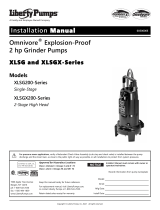 Liberty Pumps XLSG200-Series Omnivore Explosion-Proof 2 hp Grinder Pump User manual
Liberty Pumps XLSG200-Series Omnivore Explosion-Proof 2 hp Grinder Pump User manual
-
Liberty Pumps 5488000A User manual
-
Liberty Pumps K001132 Operating instructions
-
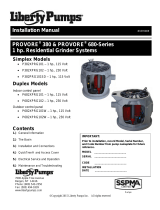 Liberty Pumps P382PRG101SD-2/A2W Installation guide
Liberty Pumps P382PRG101SD-2/A2W Installation guide
-
Liberty Pumps P382LE41 User guide
Other documents
-
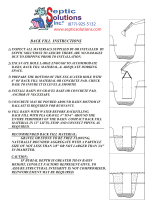 Septic Solutions LEH102A 120 Gallon Simplex Fiberglass Pump Station Operating instructions
Septic Solutions LEH102A 120 Gallon Simplex Fiberglass Pump Station Operating instructions
-
Trim-A-Slab 3080 Dimensions Guide
-
Construction Metals FVW208-12 Operating instructions
-
Redi Base RDB1 Installation guide
-
Franklin Brass 193152-SN Installation guide
-
Liberty H00930C-AB-C5 Installation guide
-
Bilco W3019-42N Operating instructions
-
Pentair WM-6QC Operating instructions
-
Franklin Electric 996781 User manual
-
Liberty Garden 1920 Installation guide












